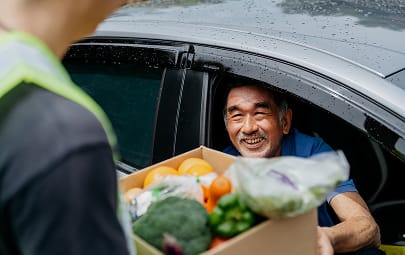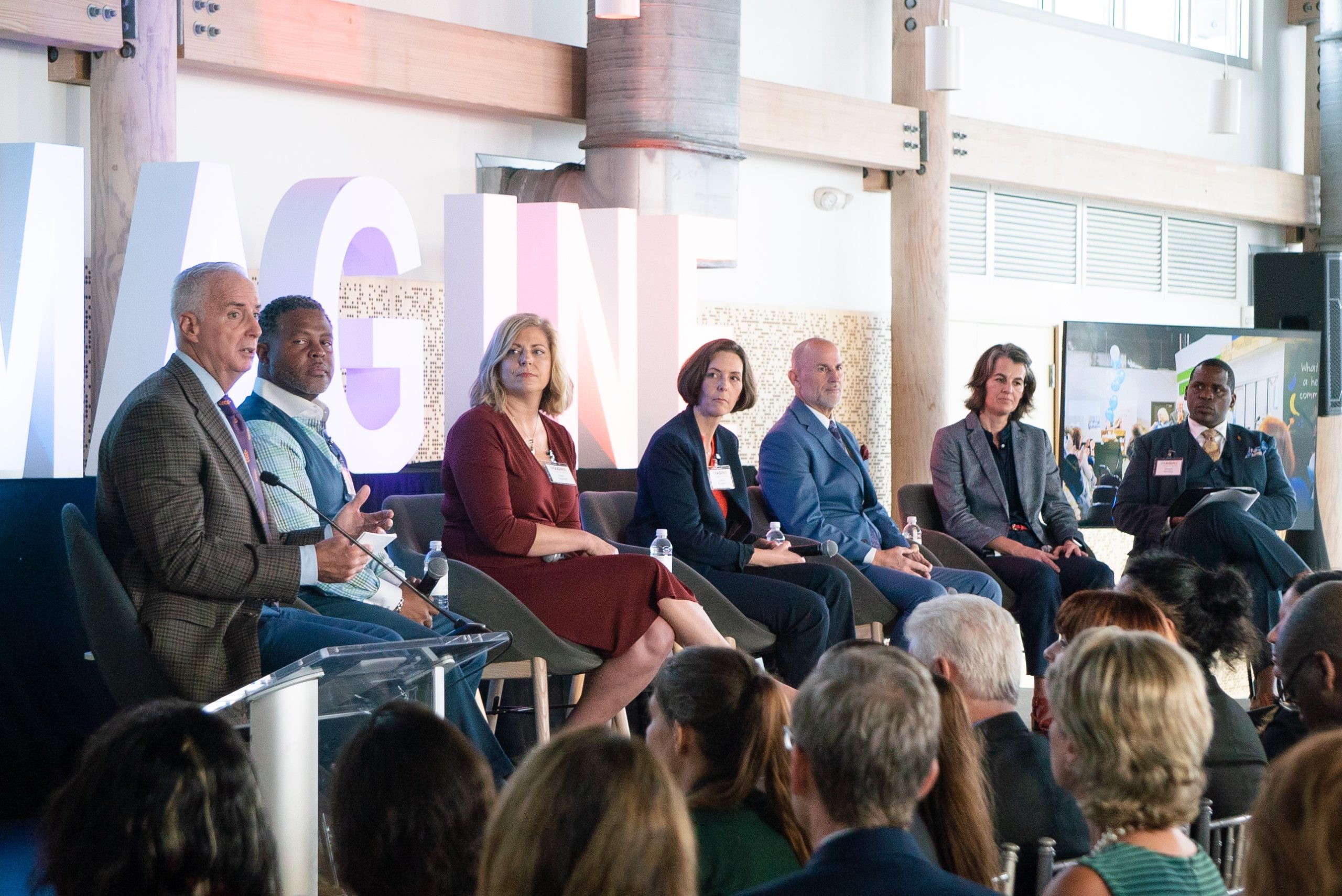Three years ago, Feeding Tampa Bay unveiled a bold vision for changing and uplifting the Tampa Bay area. One that meant stepping forward and farther into the community to imagine a future that was far different than the one we knew.
These goals were put to the test with challenges like the COVID-19 pandemic, which threatened our community’s resiliency. But the setbacks encouraged us more than ever to seek a deeper understanding of our neighbors’ needs. Since then, we have come to understand that those needs are ever-evolving, and they go far beyond our efforts to put food on the table.
On Nov. 2, Feeding Tampa Bay staff, board members, and community leaders from all social service sectors gathered together for our IMAGINE event. It was a morning filled with excitement and new possibilities. The vision was twofold: to provide people with a report card of Feeding Tampa Bay’s work over the past three years, and to outline our mission for the future given what we’ve learned so far.
How did we achieve this? Through a panel discussion with five leaders from across the community/social service spectrum:
- Katie Fitzgerald, President and COO of Feeding America, spoke about hunger on a national scale.
- Keri Eisenbeis, VP of Government and Community Relations at BayCare, spoke about hunger and health.
- Addison Davis, the Superintendent of Hillsborough County Schools, spoke about hunger and education.
- Joanna Burleson, the managing director of the Monitor Institute by Deloitte, spoke about innovation and best practices.
- Ernest Coney, President of the Corporation to Develop Communities of Tampa, spoke about hunger and the economy.
Led by Feeding Tampa Bay President Thomas Mantz and Vice Chair Kareem Spratling, the discussion centered on the importance of collaboration to address the issue of food insecurity. Here are some of the highlights of that conversation.
What we’ve worked on
In the last three years, Feeding Tampa Bay has virtually doubled the number of meals we’ve provided to the community from 45 million to almost 90 million. Although our primary responsibility was ensuring that people could get food on the table, we also invested significant time and money so that our neighbors could walk out of our warehouse and our pantries with hope for the future.
This meant investing in deep partnerships with other leaders and organizations throughout our coverage area. Food insecurity affects and is affected by healthcare, education, and economic self-sufficiency - so it was critical that we work across the spectrum to understand exactly how these issues were interconnected.
In Feeding Tampa Bay’s research, there were four E’s that we needed to address:
- Energize
Spratling began the conversation by sharing a piece of philosophy attributed to Hippocrates: “If you don’t eat food as medicine, you’ll soon eat medicine as food.”
The Energize objective refers to understanding the ways in which healthcare and hunger affect the community. Our partnership with the BayCare Health System has largely addressed this through the establishment of our FoodRx program and the new health services center located at Feeding Tampa Bay’s warehouse. Eisenbeis noted that food is a driver of chronic disease management.
BayCare and Feeding Tampa Bay have dedicated the past couple of years to tracking food insecurity among their patients, providing them with “healing bags,” and food prescriptions, and connecting them to other local food pantries as part of long-term health sustainability.
- Evolve
This objective refers to breaking down barriers (like time, distance, and money) that traditionally keep people from accessing good, healthy food. It’s about meeting people where they are.
One big aspect of this has been the establishment of school pantries, where parents can access groceries when they pick up their children from school. There are currently 74 school pantries in four counties across our coverage area. Superintendent Davis noted that food insecurity has an effect on students’ performance in school. Nourishment is a prerequisite to effective learning, so students need essentials if they are expected to thrive intellectually.
The second solution to this objective is the establishment of empowerment centers, like Feeding Pinellas. These one-stop shops, as Coney mentioned, allow people to access multiple services at the same time.
- Engage
In order to build a movement, like the one Feeding Tampa Bay is trying to rally against hunger, you have to be able to bring people into it. The pandemic brought about a critical moment of awareness regarding food insecurity. Fitzgerald talked about how 50 to 60 million people nationwide have accessed the charitable food system since the pandemic began. In fact, according to Thomas Mantz, 68% of people coming through food lines at the start of the pandemic had never before been in one. It is the job of Feeding Tampa Bay and our partners to ensure that people become more aware of the complexities of food insecurity. That way, we can have a greater ability to mobilize the movement as a whole.
- Empower
Food alone will not end hunger. Rather, it’s about providing people with the means for self-sufficiency, stability, and financial security. Long-term stability, Coney said, starts with a paycheck - that means providing people with job training services and other pathways for success. Feeding Tampa Bay has aimed to do this by starting the FRESHForce program, which connects people with industry-standard skills in 4 areas. Since its inception, there have been over 150 graduates of the program. Meals, as discussed in the panel, are a mission for the moment - but the real work starts by setting foundations for success.
Moving Forward
Challenges like the pandemic revealed the underlying fragility of the community. But they also showed us that, in order to imagine a better future, we need to build a community that can withstand monumental setbacks.
Food insecurity is, as Burleson said, a cloud problem. This means that it’s complex, always shifting, and not bound by time. The best way to understand its complexities and root causes is by speaking with our neighbors who are directly affected by it. That way, we can figure out the unique ways in which hunger affects different populations.
Blanket solutions don’t work toward ending hunger. Rather, success is dependent on our consideration of people’s norms, awareness, and capacities to access food and other resources. Moreover, our community is interdependent, and so the work we do also has to be interdependent. That’s why our partnerships moving forward are so important.
For the future, Feeding Tampa Bay imagines the following:
- Strengthened partnerships that better address gaps in resource access
- Closing the gap between income and expenses, and creating household stability
- Holistic, client-centered services
- Better use of relationships and technology to enhance knowledge and awareness about food insecurity
- Maximizing the use of our services
- Better advocacy and policies, both at the local and national levels
- A place that meets people where they are
As we soon step into 2023 with the promise of a new facility, we hope to provide our community with more collaborative, holistic support. Together, we can work toward imagining a hunger-free Tampa Bay.
By Hannah Himmelgreen







